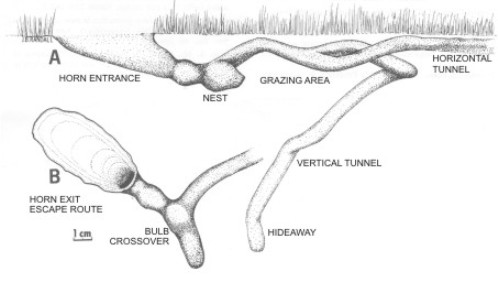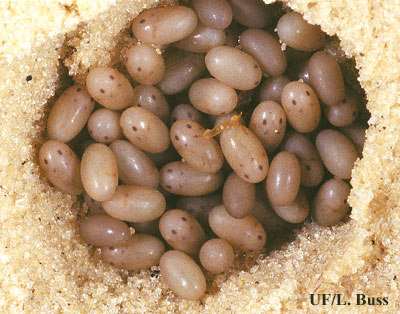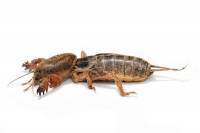You may associate their song with summer when it hits its peak, but their singing will continue into early fall.
There are eight major groups of crickets in North America including mole crickets (family Gryllotalpidae). The family is comprised of seven species, four of which are exotic. The most notorious of the bunch is the very successful and widespread Southern Mole Cricket. It is a large and destructive introduced cricket which often becomes problematic in yards, crops and gardens.
 Wisconsin’s most common mole cricket is the Northern Mole Cricket. It is native and found throughout much of the eastern U.S. While a powerful digger, it is much less destructive than the southern species and only rarely considered a nuisance in turf lawns. The Northern Mole Cricket is found in wet soils along ponds, streams, and rivers. It is rarely seen because it spends most of its life in extensive underground tunnels. It amplifies its volume by singing into carefully sculpted megaphone-shaped hollows (shown at right).
Wisconsin’s most common mole cricket is the Northern Mole Cricket. It is native and found throughout much of the eastern U.S. While a powerful digger, it is much less destructive than the southern species and only rarely considered a nuisance in turf lawns. The Northern Mole Cricket is found in wet soils along ponds, streams, and rivers. It is rarely seen because it spends most of its life in extensive underground tunnels. It amplifies its volume by singing into carefully sculpted megaphone-shaped hollows (shown at right).
 The mole cricket gets its name from its mole-like shape of its body and forelegs. The forelegs are wide and shovel-like (shown at left), much like that of a mammalian mole. The legs are situated with two or four dactyls, which look almost tooth-like and assist in digging. Most introduced species have two larger dactyls while most native species have four, smaller ones. All species of mole crickets are hairy and have a large shield-like pronotum at the top-most, dorsal part of the thorax (thought to aid in digging). Due to their nocturnal, underground nature, they have tiny eyes situated on either side of their head. Mole crickets are adept flyers and because they are not strong hoppers, they tend to fly from location to location rather than hop.
The mole cricket gets its name from its mole-like shape of its body and forelegs. The forelegs are wide and shovel-like (shown at left), much like that of a mammalian mole. The legs are situated with two or four dactyls, which look almost tooth-like and assist in digging. Most introduced species have two larger dactyls while most native species have four, smaller ones. All species of mole crickets are hairy and have a large shield-like pronotum at the top-most, dorsal part of the thorax (thought to aid in digging). Due to their nocturnal, underground nature, they have tiny eyes situated on either side of their head. Mole crickets are adept flyers and because they are not strong hoppers, they tend to fly from location to location rather than hop.
 Female mole crickets dig special chambers for their eggs. Up to 100 bean-shaped eggs (shown at right) are laid in the summer and hatch as nymphs in the late summer/early fall. The nymphs dig to the surface where they will become mature and lay their own eggs the following summer.
Female mole crickets dig special chambers for their eggs. Up to 100 bean-shaped eggs (shown at right) are laid in the summer and hatch as nymphs in the late summer/early fall. The nymphs dig to the surface where they will become mature and lay their own eggs the following summer.
Mole crickets are omnivores and their diet includes grubs, roots, other invertebrates and grass. Some of their biggest predators are birds, raccoons, wasps, and small mammals. Mole crickets have been known to bite humans, but will only do so if handled.
Fun Facts:
- The typical life span of a mole cricket is two years.
- The male mole cricket’s song is said to be similar to that of a nightjar Caprimulgus europeaeus.
- Friendly wasps? The Larra bi-color wasp feeds primarily on mole crickets and is one of the few things known to keep the destructive Southern Mole Cricket in check.
- Mole crickets are found on every continent except Antarctica.
- In parts of East-Asia, mole crickets are often fried and eaten as food.
* This article written using information from the books Insects: Their Natural History and Diversity and Field Guide to Insects of North America, the websites http://entomology.ifas.ufl.edu/, wikipedia.org, www.arkive.org and the links http://entnemdept.ufl.edu/creatures/orn/turf/pest_mole_crickets.htm, http://entomology.ifas.ufl.edu/fasulo/molecrickets/mcri0038.htm, http://en.wikipedia.org/wiki/Mole_cricket, http://www.arkive.org/mole-cricket/gryllotalpa-gryllotalpa/.





